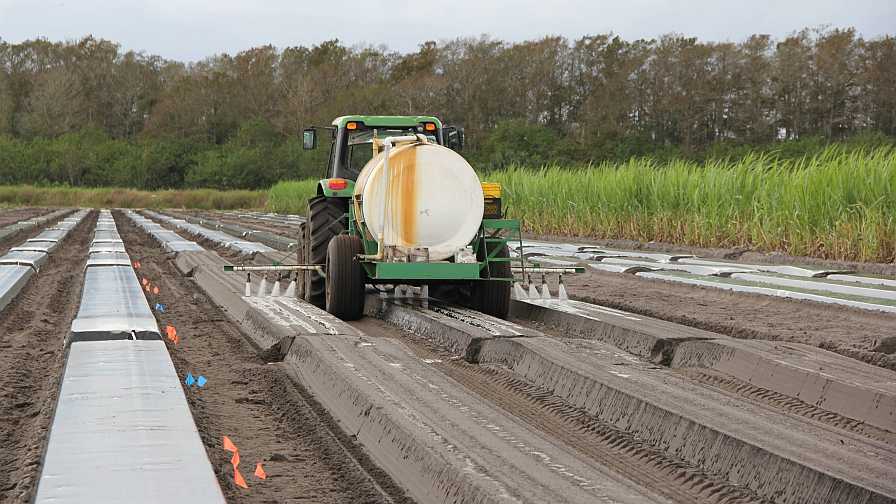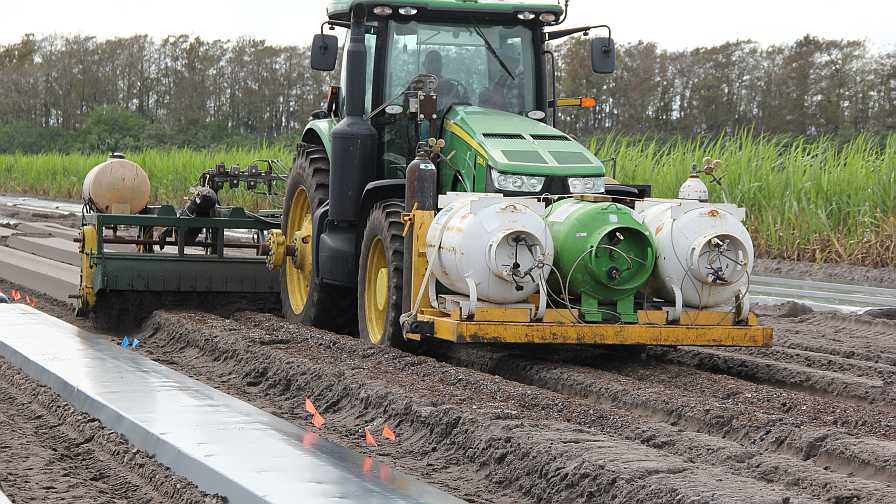Tips for Sustainable Soil Disinfestation in Vegetables
Methyl bromide and other soil fumigants have been heavily relied upon to control soilborne plant pathogens, nematodes, and weeds in polyethylene-mulched vegetable production in Florida. However, negative aspects of their use on the environment and human health have increased the interest in different non-chemical, sustainable methods.
Alternative Approach
Many of Florida’s vegetable production soils are generally sandy-textured, low in organic matter, nutrients, and water-holding capacity, and therefore inherently low in fertility and highly leachable. Anaerobic soil disinfestation (ASD) also known as biological soil disinfestation or reductive soil disinfestation is a pre-plant, non-chemical soil disinfestation technique increasingly proposed as an alternative to chemical soil fumigation for the control of several soilborne diseases, plant-parasitic nematodes, and weeds in different vegetables and fruit crops.
Developed independently in Japan and The Netherlands, for both open field and protected crops, the technique is gaining interest in the U.S., China, and other countries. The principle of the technique is to create a temporary anaerobic soil environment to stimulate the growth of facultative and obligate anaerobic microorganisms, that under anaerobic conditions, decompose the available carbon source, producing organic acids, aldehydes, alcohols, ammonia, metal ions, and volatile organic compounds, that are suppressive or toxic for several soilborne pests and diseases. However, its mechanism of control is still not fully understood, and a number of researchers around the world are working to explain the changes occurring in the soil during the ASD treatment and what is behind it.

Here, the soil is amended with a readily decomposing source of carbon to initiate rapid microbial growth. In this case, composted manure and a topping of molasses.
Photo by Monica Ozores-Hampton
Application Techniques
The ASD treatment can be applied to any plasticulture crops or organic crop production such as potatoes to reduce the weeds, nematodes, and soilborne diseases in three steps in organic potatoes production:
1) Amending the soil with a readily decomposable carbon source (horse manure and molasses) to initiate rapid soil microbial growth and respiration.
2) Irrigating the soil to saturate the pore space and further reduce the presence of oxygen and covering the bed with oxygen impermeable polyethylene mulch to prevent the diffusion of oxygen from the soil surface.
3) Selection of optimal soil amendments and application rates is critical for successful application of ASD.
Therefore, the objective of this study was to evaluate the effects of different soil amendments for ASD on cumulative soil anaerobiosis, plant growth, fruit yield, and postharvest quality of fresh-market tomato.
In the field experiment conducted during the fall of 2016 in Immokalee, FL, six soil treatments were evaluated:
Treatment 1
4.5 tons/acre of composted broiler litter + 741 gallons/acre of molasses
Treatment 2
12 tons/acre of composted yard trimming waste + 741 gallons/acre of molasses
Treatment 3
6 tons/acre of composted yard trimming waste + 741 gallons/acre of molasses
Treatment 4
Soil Symphony Program (Terra Feed Company)
Treatment 5
12 tons/acre composted yard trimming waste
Treatment 6
12 tons/acre composted yard trimming waste + Soil Symphony Program
These treatments were compared to an utreated control check (UTC) and against a standard chemical soil fumigation (CSF) treatment of [Pic-Clor 60 (1,3-cichloropropene + chloropicrin) at the rate of 200 pounds/acre]
Excluding UTC, CSF, and Soil Symphony, all treatments received an application of the herbicide Reflex (fomesafen, Syngenta) before laying film and 2 inches of initial irrigation after polyethylene mulching of totally impermeable film.

After the soil is amended, the beds are covered with oxygen-impermeable polyethylene mulch to prevent diffusion of oxygen from the soil surface.
Photo by Monica Ozores-Hampton
Results
- Cumulative soil anaerobiosis was higher in Treatment 1, compared to all the other treatments.
- Plant growth (stem, leaf, fruit) was greatest with Treatment 1and the lowest in the UTC.
- Extra-large fruit yields resulting from all of the amendment treatments were equivalent to CSF and greater than the UTC.
Total season marketable yields:
- CSF (34.8 tons/acre)
- Treatment 1 (36.6 tons/acre)
- Treatment 2 (35.2 tons/acre)
- Treatment 3 (33.5 tons/acre)
- Treatment 4 (30.07 tons/acre)
- Treatment 5 (27 tons/acre)
- Treatment 6 (33.9 tons/acre)
- UTC (23.2 tons/acre)
Color and titratable acidity were the only fruit quality parameters influenced by soil treatments.
Anaerobic soil disinfestation applied using alternative composted amendments and molasses can be a sustainable alternative to CSF, producing comparable plant growth, marketable yield, and fruit quality.
Author note: In addition, Francesco Di Gioia, Bodh Paudel, Xin Zhao, Jason Hong — all with UF/IFAS — and Erin Rosskopf of USDA-ARS participated in this study and contributed to this article.










